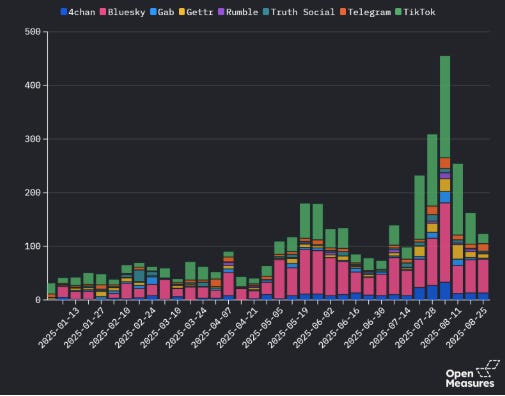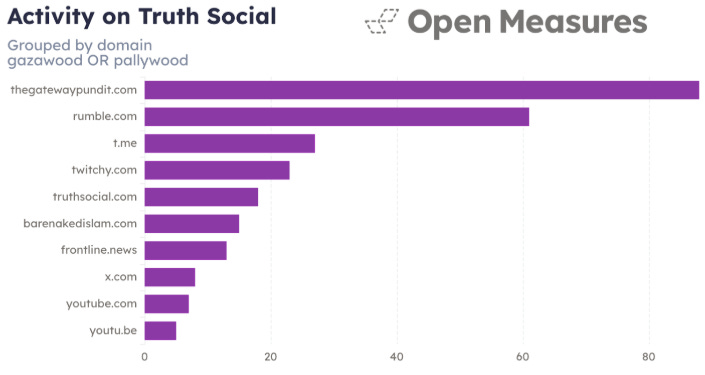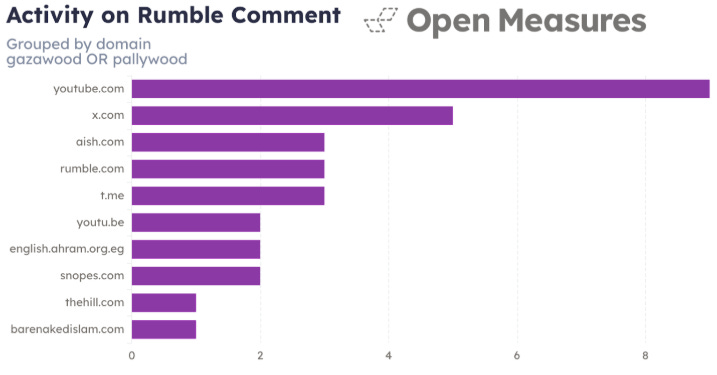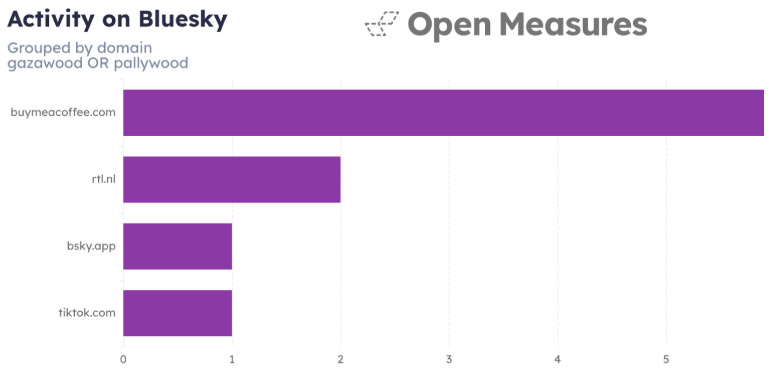‘Pallywood’ Conspiracy Theories Saw Increased Interest After Reports of Famine in Gaza
Tracking the prevalence of 'Pallywood' and 'Gazawood' conspiracy narratives across online platforms
TLDR
During the Israel-Gaza war, online narratives have emerged framing the reports of suffering and violence affecting Palestinian civilians as exaggerated or false. The most extreme versions of these claims, facetiously dubbed “Pallywood” or “Gazawood,” have alleged that Palestinians have staged fictitious scenes in order to manipulate global opinion about Israel.
Open Measures examined posts containing the terms “Pallywood” and “Gazawood” across various sources. We observed the highest volume of posts including these terms shortly after the onset of conflict in 2023 and after Israeli officials denied reports of famine in Gaza in July 2025.
Using Open Measures data, we found that the platforms where these posts most frequently appeared changed over time. Nearer to the start of the Gaza war, these posts tended to appear on alt-platforms catering to large conservative user bases like 4chan and Truth Social. In 2025, however, more of these posts were found on TikTok and Bluesky.
When posts on alternative platforms included external links, they frequently directed users to explicit anti-Islam blogs, pro-Trump news websites, and to other posts on X (formerly Twitter).
Background
On Oct. 7, 2023, Hamas led a series of attacks against Israel in which militants killed about 1,200 Israelis and took another 250 hostage. Israel responded with a military offensive in Gaza that has killed tens of thousands of Palestinians; Israeli military intelligence reports indicate that 83% of the people its military actions have killed in Gaza have been civilians.1 Israel has faced international outrage and condemnation for killing Palestinian civilians and for its reported exacerbation of humanitarian crises affecting Gazans.2
Some pro-Israel voices on social media have sought to deny and discredit news reports and graphic images from journalists covering the Gaza war that showcase the devastation that Palestinian civilians have endured throughout the conflict. The most extreme narratives have alleged that Palestinian journalists have fabricated and staged graphic scenes to undermine public opinion about Israel.
Origins of “Pallywood” and “Gazawood”
These narratives have revamped facetious terms first popularized around the turn of the century – like “Pallywood” and “Gazawood” – to compare the footage to Hollywood films.3 Pro-Israeli media advocates were first reported using the term “Pallywood” in the early 2000s, while attempting to discredit news footage of a young Palestinian boy who was shot and killed during a military standoff.4
Vocal proponents of “Pallywood” and “Gazawood” conspiracy theories have also argued that news media workers reporting on dire situations affecting Gazans are themselves Hamas sympathizers and collaborators. Israel, which has systematically targeted news media workers in military strikes and later claimed the slain workers were secretly partnered with Hamas, has cited the same line of attack in its own official communications.
News Media Casualties
Since the war began in 2023, Israel has required international news media entering Gaza to embed with its military and its spokespeople, meaning that independent reporting from Gaza has come exclusively from Palestinian journalists – who pro-Israel advocates have categorically sought to portray as untrustworthy.5
In several cases, Israel and its most aggressive advocates have claimed without hard evidence that journalists killed by the Israeli military were clandestine Hamas operatives.6 By conservative counts, the Israeli military has killed at least 189 reporters and news media workers since the start of the Israel-Gaza war in Oct. 2023 (though many organizations have reported higher totals). Even by conservative figures, it has been the deadliest conflict for journalists in recorded history.
Analysis
Open Measures used our platform’s Timeline function to determine how many posts in our data included the terms “Pallywood” or “Gazawood” between Oct. 7, 2023 (the day Hamas executed a terror attack against Israel) and Sept. 3, 2025. Researchers compiled weekly counts of posts mentioning these terms verbatim on 4chan, Bluesky, Gab, Gettr, Rumble, Truth Social, Telegram, and TikTok. These platforms were selected because of their relative volume of activity as compared to other sources in Open Measures’ datasets.
Near the onset of the Israel–Gaza war in 2023, researchers observed a spike in posts containing at least one of the keywords above. Posts containing these keywords were counted less frequently across all sources throughout 2024, but began to re-appear more frequently in 2025. (It is important to note that some posts mentioning these keywords did so to criticize others using them, not to promote the narrative themselves.)

Open Measures researchers used our dashboard’s Discover function to review posts mentioning these terms. Our researchers found that the terms regularly appeared in response to other posts reporting on conditions in Gaza, alleging that any media featured in those posts had been staged and that news organizations covering the conflict were complicit in perpetuating false claims.
One example of these claims was found shared on Bluesky on Sept. 1, 2025:
Gazawood is a real problem. There's absolutely fake journalist out there simping for Hamas
Another appeared on TikTok on Aug. 26, 2025:
israel gives warning to the area they will attack, and still these people uses children to manipulate the media. search ‘gazawood’ or ‘pallywood’, trust me
July/August 2025 Surge
The most recent uptick in usage of the terms “Pallywood” and “Gazawood” coincided with news coverage in July about widespread starvation in Gaza.7 At the time, a wave of pro-Israel influencers initially claimed that images and videos showing the effects of the famine in Gaza had been mis-contextualized or staged, which seemed to reignite broader “Pallywood” and “Gazawood” claims.8

Across platforms, mentions of these keywords spiked to their highest recorded levels after Israeli Prime Minister Benjamin Netanyahu denied that Gazans were suffering from starvation as a result of Israel’s restrictions on humanitarian aid entering the region.9 Some posts containing the terms “Pallywood” and “Gazawood” echoed these claims, and some questioned whether Gazans were starving at all.
One explanation for the timing of this spike could be the existence of a “legitimization cell” in Israel's intelligence apparatus, specifically created to cast doubt on news from Gaza that could harm Israel's image abroad, such as images of starvation. According to an insider source who spoke to Israeli investigative platform +927 Magazine:
. . . whenever criticism of Israel in the media intensified on a particular issue, the Legitimization Cell was told to find intelligence that could be declassified and employed publicly to counter the narrative.
From TikTok on Aug. 22, 2025:
Where is this alleged famine??? Think you guys have been fooled. This looks nothing like a gcide or a hunger crisis. Maybe they should see what’s actually happening in Sudan or Yemen. Oh yeah. There’s no money to be made off those conflicts. #gazawood #pallywoodexposed #nostarvation #luckyones #medialies
On Aug. 10, Israeli’s military targeted and killed an Al Jazeera reporter who covered the hunger crisis after a military spokesperson accused him of participating in “Hamas’ false starvation campaign.”10
Shifting Platform Dynamics
Our researchers found posts containing “Pallywood” or “Gazawood” across all sources reviewed but also observed that their frequency on various platforms changed over time.
Initially, Open Measures recorded more posts containing these terms on alt-platforms that have traditionally catered to conservative communities like 4chan and Truth Social. But over the last year, Open Measures recorded more posts containing them on Bluesky and TikTok. In 2025, these represented a higher percentage of total posts containing these terms.

Some amount of this shift can likely be attributed to the wider adoption of Bluesky after the 2024 US presidential election, when millions of former X users decamped to the alternative platform.11
Outside Sources
Using the Activity function in Open Measures’ platform, our researchers examined the URLs users included in posts mentioning either “Pallywood” or “Gazawood” since Oct. 7, 2023. The top domains for links included in those posts varied between platforms, but the top three domains included in these posts were as follows:
4chan: Twitter (now X), Israeli news site Rotter, and other 4chan posts
Bluesky: Crowdfunding site Buy Me a Coffee, Dutch news site RTL, and other Bluesky posts
Gab: Anti-Islam blog Bare Naked Islam, anti-Islam blog Helplev, and Twitter (now X)
Gettr: Alt-tech messaging platform Telegram, conservative news blog The Gateway Pundit, and alt-tech video-sharing platform Rumble
Rumble: YouTube, Twitter (now X), and Jewish website Aish
TikTok: Telegram (very few links were recorded on TikTok)
Truth Social: The Gateway Pundit, Rumble, and Telegram
In our analysis of links shared, our researchers noted a significant amount of cross-platform sharing. In addition to news blogs, top-linked domains often pointed to content shared on mainstream platforms and other alt-platforms. There are a number of reasons to share links from one platform to another, with one possible explanation being an attempt to amplify consistent messaging to a range of audiences.
Conclusion
Conspiracy narratives alleging that Palestinians have orchestrated and staged scenes of mass suffering to manipulate global opinion against Israel – dubbed “Pallywood” and “Gazawood” by their proponents – received a fresh wave of interest following reports of famine in Gaza.
Open Measures found that the platforms where these terms appeared has shifted over time, suggesting that they may be reaching new audiences or that users promoting them have migrated to new online spaces. Of the posts using these terms, those that included links frequently directed to posts on other social media platforms and to a handful of blogs, including some known for publishing hyper-partisan news commentary and anti-Islam rhetoric.
In the interest of helping researchers slow the spread of misinformation and propaganda that could cost lives, Open Measures will continue to monitor and report on these trends.
Identify disinformation and extremism with the Open Measures platform.
Organizations use Open Measures’ tooling every day to track trends related to networks of influence, coordinated harassment campaigns, and state-backed info ops.
Emma Graham-Harrison and Yuval Abraham. “Revealed: Israeli military’s own data indicates civilian death rate of 83% in Gaza war.” The Guardian. 21 Aug. 2025. Here.
Chantal Da Silva. “Dead children, malnutrition and a lack of aid: Gaza's humanitarian crisis worsens.” The Guardian. 21 July 2025. Here.
Olga Robinson and Shayan Sardarizadeh. “False claims of staged deaths surge in Israel-Gaza war.” BBC News. 21 Dec. 2023. Here.
Calev Ben-David. “Between the Lines: Caught in the Mohammad al-Dura crossfire.” Jerusalem Post. 11 Oct. 2007. Here.
Aya Batrawy. “Media outlets demand Israel grant access to Gaza, halt attacks on journalists there.” NPR. 1 Sept. 2025. Here.
Emma Graham-Harrison. “Israeli unit tasked with smearing Gaza journalists as Hamas fighters – report.” The Guardian. 15 Aug. 2025. Here.
Emma Graham-Harrison. “The mathematics of starvation: how Israel caused a famine in Gaza.” The Guardian. 31 July 2025. Here.
“Debunked images: Pro-Israeli influencers claim famine in Gaza is staged.” France24. 31 Aug. 2025. Here.
Cara Anna. “Israel’s leader claims no one in Gaza is starving. Data and witnesses disagree.” Associated Press. 28 July 2025. Here.




